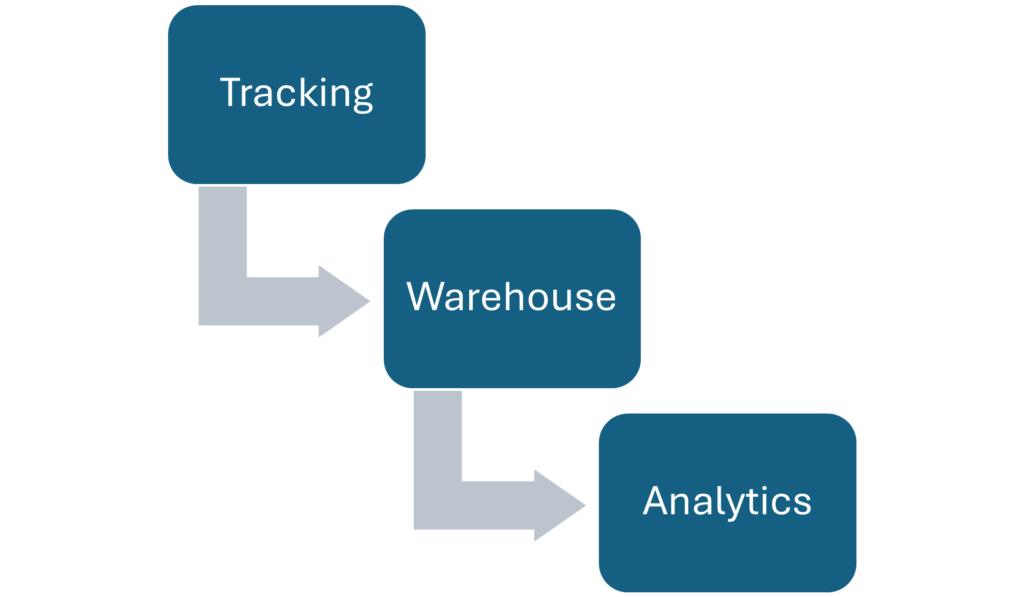
How much do I need to sell the concept of using data to inform marketing decisions?
The difference is massive.
By using data to inform campaigns, marketers have a dramatically better view of the efficiency and effectiveness of their funnels and marketing assets.
The end result is more definitive resource allocation, higher ROI on campaigns, and testable funnels with detailed analytics.
Marketing operations improve ROI and campaign performance through continuous optimization, effective resource allocation, data-driven decision-making, personalization, compliance, and enhanced collaboration.
Embracing data in marketing means utilizing insights to guide strategies, personalize experiences, measure success, and predict trends, leading to more informed decisions and successful outcomes.
1
What Is Data Marketing?
Simply put, data marketing is the combination of high-quality marketing operations and an experimental growth marketing structure.
This requires two things up front.
First, we must have the infrastructure in place to properly collect, analyze, and use data points.
Second, we must have implemented an experimental growth mindset and have buy-in from all key decision makers on how new campaigns will be launched, tested, and analyzed.
By understanding the behaviors, preferences, and needs of our target audience, we can create much more personalized and effective campaigns.
Data-driven marketing means using high-quality metrics and KPIs to regularly measure the success of campaigns, making real-time adjustments to optimize performance, and predicting future trends to stay ahead of the competition.
It also involves segmenting audiences for targeted messaging, testing different strategies to see what works best, and using insights to improve customer experiences and drive conversions.
Ultimately, using data in marketing leads to more informed decision-making, higher efficiency and predictability, and better ROI.
2
So, What Did The Campaign Do?
Marketing operations is too often an afterthought in many organizations.
It’s a natural inclination to want to jump straight into “the interesting stuff.” Let’s build some landing pages and narrow down an audience and start putting together some ads.
Yes, these things are fun. But without the proper infrastructure in place to really understand the effects of our actions, we’re just throwing darts in the dark. If we hit a bullseye, it’s mostly luck and we’ll have a tough time knowing why and trying to replicate it.
Then comes a myriad of excuses.
“The audience is exhausted.”
“We need new creatives.”
“Competition is up.”
Marketing operations is a critical function within a marketing department that focuses on the strategic management and optimization of marketing processes, technologies, and data.
It serves as the backbone of marketing efforts, ensuring that campaigns are executed efficiently, resources are allocated effectively, and data is leveraged to inform decision-making.
Marketing operations encompass a range of activities, including technology implementation, campaign management, process optimization, data analysis, and budget management. By streamlining and consolidating these activities, marketing operations enable marketers to achieve their goals more effectively and with far greater precision.
3
Out-Of-The-Box GA4 Is NOT Sufficient
Data is a powerful asset for marketers.
And it’s no longer optional.
People are inundated with marketing and sales content daily. The introduction of AI and attempts at scaled personalization have made it more difficult than ever to stand out from your competition.
Data is the answer.
Better decision making and performance measurement are givens.
I’m often surprised at just how weak a link this is at many organizations though.
Someone sets up a GA4 instance and uses out-of-the-box settings to report on campaign effectiveness. And that’s the full depth of analysis.
We spent this much. The campaign delivered this many people to the landing page. And we signed up this many new customers.
How many new signups came specifically from that campaign?
Well, the UTMs drop when they sign up on the app, but I can tell you how many people clicked the link.
That’s really not good enough.
And we’re missing so much in what this audience actually looks like.
What other content did they browse? What parts of the page made them stop? How long did they browse? What happens after they signup?
The room goes silent.
A simplistic understanding of customer behavior means we can’t target or retarget efficiently.
It means we can’t provide tailored customer experiences because we have no way of predicting what groups of customers want and need.
It doesn’t need to be this way.
4
Limited Stacks & Siloed Data
A marketing technology stack, or martech stack, is a collection of tools and platforms that marketers use to execute, manage, and analyze their marketing activities.
Most companies have some marketing technology stack, though it is often very poorly integrated and therefore doesn’t provide much useful information.
This can lead to several significant challenges and inefficiencies, not least of which is siloed data.
Data is siloed when it is warehoused in a specific tool and is either difficult to extract or difficult to combine with other data sources. The result is an incomplete view of marketing activities and poor and inconsistent reporting.
Inefficiency is another major problem when the tech stack isn’t working well. The cost in terms of time and effort spent in manual processes, data analysis, and other inefficient uses of time are staggering.
Not to mention the frustration and burnout such activities can cause.
Limited tech stacks make scalability difficult, data unreliable, and ultimately decrease the value of a company as questions of data reliability opens a whole Pandora’s Box of other uncomfortable questions about total reliability and acquisition repeatability.
5
The Basic Stack
Having the right marketing technology stack is crucial for the success of marketing operations.
There are 3 basic components to a good martech stack: 1) tracking, 2) a data warehouse, and 3) an analytics platform.

Having this basic stack in place gives you the infrastructure you need to get the most out of your business data.
Each piece of the stack can have multiple components depending on the business type.
A simple ecommerce business might need pretty basic elements at each level. Whereas a complicated SaaS business with multiple tools and properties may require several integrated technologies at each level.
Once the pieces are in place, the benefits become clear.
Repetitive tasks can be automated. Workflows are streamlined. Fewer processes require manual effort. Platforms communicate better and data is integrated across key tools. Reporting and experimentation are massively more effective.
6
Immediate Improvements
Once you’ve successfully implemented a good martech stack, the possibilities are endless.
Here are a few of the key improvements you’ll experience immediately:
- Campaign Optimization: By leveraging data and analytics, you can identify the most effective strategies and tactics for each campaign. For example, A/B testing can be used to determine which messages, images, or calls to action perform best. This continuous optimization leads to higher engagement and conversion rates, ultimately improving ROI.
- Resource Allocation: You can ensure that resources are allocated effectively across different campaigns and channels. By analyzing past performance and forecasting future trends, you can allocate budget and resources to the most profitable activities. This leads to better financial management and higher returns on marketing investments.
- Process Efficiency: Streamlined processes and automated workflows reduce the time and effort required to execute marketing activities. This allows you to launch campaigns faster and with fewer resources. For example, marketing automation tools can handle email marketing, social media posting, and lead nurturing, freeing up time for strategic planning and creative work.
- Data-Driven Decision-Making: You’ll have the data and insights needed to make informed decisions. By analyzing customer behavior, market trends, and campaign performance, marketing operations can guide strategic planning and execution. This leads to more effective marketing strategies and higher campaign performance.
- Personalization: You’ll be able to deliver personalized experiences at scale. By using data to understand customer preferences and behaviors, you’ll have the ability to create tailored messages and offers for different segments of your audience. This leads to higher engagement, increased loyalty, and better overall campaign performance.
- Collaboration and Coordination: These systems make is far easier to facilitate collaboration and coordination among different teams and stakeholders. By ensuring clear communication and alignment, teams work together more effectively. This leads to more cohesive campaigns, faster execution, and better results.
- Scalability: Better data supports the growth and scalability of all your marketing efforts. By implementing scalable processes and technologies, you can handle larger volumes of data, interactions, and campaigns. This supports expansion into new markets and the execution of more complex marketing strategies.
7
Conclusion
Data is a critical component to any successful marketing strategy.
Building the right technology stack enables good data flows and ultimately helps to improve campaign execution, experimentation, and analysis.
You’ll also be able to minimize manual processes, increase your speed of execution, and create more personalized experiences at scale.
Organizations that invest in data marketing are far better positioned to achieve their marketing goals, deliver exceptional customer experiences, and drive revenue growth.






